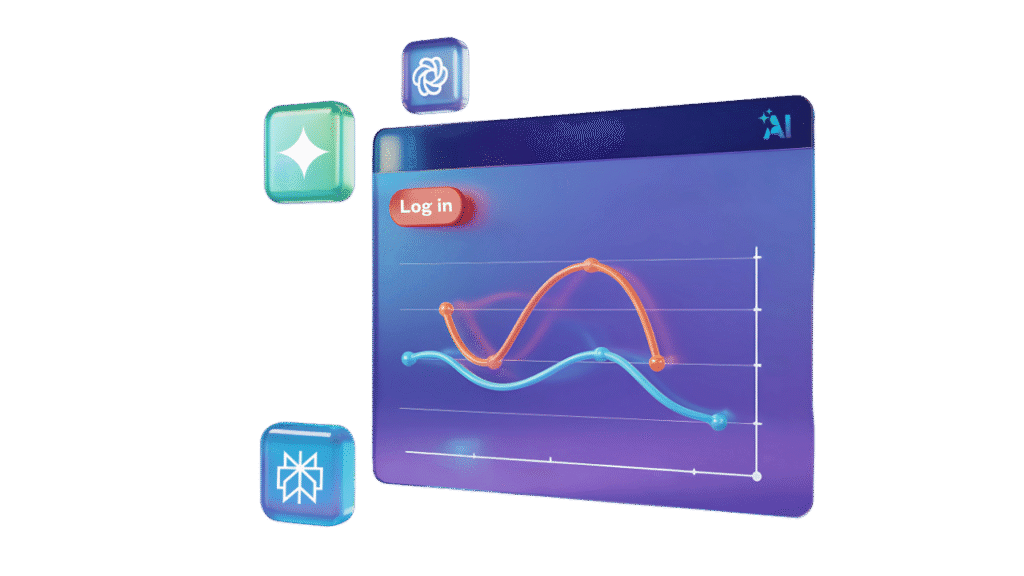how to localize SaaS UI quickly
AI Search Visibility Analysis
Analyze how brands appear across multiple AI search platforms for a specific query
informational
Software & SaaS
Analyzed 07/15/2025

Brand Presence
Number of AI platforms where your brand is surfaced in response to a specific prompt or query
High Impact
AI Link Citations
Indicates how many times your brand’s website was linked within AI-generated responses
High Impact
AI-Brand Mentions
Total instances where your brand is referenced across AI platforms in response to a specific query
High Impact
Brand Sentiment
Sentiment expressed when your brand is mentioned across AI platforms
High Impact
Platform-Wise Brand Performance
| Brand | Total Mentions | Platform Coverage Map | Backlinks | Sentiment |
|---|---|---|---|---|
| 1 Lokalise | 4 ⬈ |


|
3 🔗 |
|
| 2 Gridly | 2 ⬈ |

|
1 🔗 |
|
| 3 Mockplus | 2 ⬈ |

|
1 🔗 |
|
| 4 Smartling | 1 ⬈ |

|
1 🔗 |
|
| 5 Crowdin | 1 ⬈ |

|
1 🔗 |
|
| 6 Transifex | 1 ⬈ |

|
1 🔗 |
|
Brand Analytics
- While no single tool completely dominates, Lokalise is the most frequently mentioned across
ChatGPT and Perplexity responses for modern SaaS localization. It offers:
|
- Git-based CI/CD integration
- In-context previews
- Translation memory
- Workflow automation for product and dev teams
Provider Gap
ChatGPT provides the clearest tactical roadmap, including tools (Lokalise, Transifex), testing best practices, and workflow design tips.
Perplexity dives deeper into translation memory, native team building, and market-fit validation using localization research loops.
Google AI returned no relevant response, indicating a visibility gap for localization tools in its AI summaries—presenting a clear AIO/AEO opportunity for platforms like Lokalise and Crowdin.
Citation Potential
- Tool Comparisons
- Lokalise vs Crowdin vs Transifex: Best SaaS localization tools in 2025
- Smartling vs Phrase: Enterprise vs mid-market showdown
- Templates & Guides
- JSON string extraction template for SaaS teams
- Localization QA checklist (RTL, text expansion, date/time formats)
- Technical Blogs
- Automate localization with GitHub Actions
- Translation memory: Save time, boost consistency
- SEO Topics
- Top 5 localization tools for SaaS in 2025
- Why global users churn without localized UI
- How to test multilingual UIs for layout & legibility
- Niche Angles
- Gaming vs SaaS localization (Gridly vs Lokalise)
- Onboarding localization in user-first SaaS products
Key Insight
- Structure & Flow – All platforms emphasize a clear agenda, logical progression (problem → solution → CTA), and strong closing with next steps.
- Pain Point Focus – Successful scripts start with discovery, recap prospect challenges, and tailor the demo to address them directly.
- Interactive Demos – Engage prospects with questions, visuals, and real-world examples—avoid monologues.
- Handle Objections Early – Use case studies, testimonials, or data to address concerns before they derail the conversation.
- Social Proof Matters – Highlight competitor differentiators and share relevant success stories to build credibility.
- Stay Flexible – Adapt the script based on prospect responses—rigid pitches feel impersonal.
AI Search Engine Responses
Compare how different AI search engines respond to this query
ChatGPT
2512 WordsMentioned Brands
Summary
ChatGPT provides a structured 6-step approach to SaaS UI localization, emphasizing planning for internationalization from the start, externalizing content, automating processes with platforms like Lokalise and Transifex, implementing continuous localization, collaborating with native speakers, and thorough testing. The response focuses on integrating localization into development workflows to achieve rapid and effective results.Full Report
Conducting an effective SaaS demo call is crucial for showcasing your product's value and addressing potential clients' needs. Below is a structured script template to guide you through a successful demo:
-
Prepare for Localization (i18n)
- Externalize UI strings: Move all visible text (e.g., labels, tooltips, buttons) into JSON or i18n files.
- Example: {"signup_button": "Sign up"}
- Use i18n libraries:
- React: react-i18next, formatjs
- Vue: vue-i18n
- Angular: @ngx-translate/core
-
Automate String Extraction
- Use CLI tools or scripts to auto-extract strings into language files.
- For example:
- i18next-scanner (for React)
- Custom regex parser for JSON/JS files
-
Use a Localization Platform
To collaborate, manage, and sync translations:
- Top tools:
- Lokalise dev-friendly, great GitHub & Figma integration
- Crowdin ideal for agile teams with continuous delivery
- Transifexgood for API-driven workflows
- Features to look for:
- In-context editing
- GitHub/GitLab sync
- Auto-machine translation + human review
- Translation memory (TM)
-
Enable Continuous Localization (CL)
- Use GitHub Actions or CI/CD pipelines to auto-push new strings to your localization tool and pull updates.
- Automate:
- Extracting new strings → pushing to platform
- Pulling translated files → adding to codebase
-
Leverage Machine Translation (MT) + Post-editing
- Use AI translation (DeepL, Google, Lokalise AI) for speed.
- Then, assign language reviewers or native-speaking freelancers to refine key screens.
-
Run Localization QA
- Text expansion in other languages (e.g., German)
- RTL layout support (e.g., Arabic, Hebrew)
- Date/time/number formatting
- Broken layout or string overflows
Check:
Tools like Lokalise QA, Pseudo-localization, or even Playwright-based screenshot testing help.
-
Bonus: Localization Checklist
- All strings extracted from code
- Language switcher enabled
- Default & fallback languages set
- Translations loaded asynchronously
- Responsive UI with dynamic string lengths
- Legal/compliance translations (ToS, GDPR)
-
Need Templates?
- A JSON string extraction template
- GitHub Action YAML for CL
- A localization QA checklist
Let me know if you want:
Or I can help you compare Lokalise vs Crowdin based on your team's needs.
Google AI Overview
3291 WordsSummary
To quickly localize a SaaS UI, focus on identifying all translatable text, use a translation management system (TMS) to centralize and automate translation workflows, and leverage translation memory (TM) to reuse existing translations for consistency and speed. Prepare your UI with flexible layouts, modular content, and avoid hardcoding text to accommodate different languages and cultures. Prioritize clear, concise original copy and provide translators with context for accuracy. Select target languages based on user data and market goals, and combine machine translation with human review for quality. Implement thorough QA, cultural adaptations, and ensure support for right-to-left languages. Establish a style guide and maintain cross-functional team collaboration to ensure consistency and smooth communication throughout localization
References (10)
Full Report
To quickly localize a SaaS UI, focus on identifying translatable text, utilizing translation management systems (TMS) and translation memory (TM), and automating localization workflows. Prioritize clear and concise language in the original UI, build from a localization-ready foundation, and establish a style guide for consistent terminology and formatting across languages
Here's a more detailed breakdown:
-
Prepare your UI for Localization:
-
Flexible Layouts:
Design your UI with flexible layouts that can accommodate different text lengths and cultural variations in text direction (right-to-left or left-to-right). -
Modular Content:
Keep content modular, so only localized elements need updating, not core product components. -
Avoid Hardcoding:
Don't hardcode text or culturally specific visuals directly into the UI. -
Contextualize:
Provide sufficient context for translators, including screenshots, user flows, and descriptions, to ensure accurate translations.
-
Flexible Layouts:
-
Choose Your Target Languages and Markets:
- Research:,br> Analyze your user data (e.g., from Google Analytics), conduct market research, and consider your business goals to determine which languages and markets to prioritize
-
Customer Personas:
Create localized customer personas to understand their needs and pain points.
-
Translation and Localization:
-
Translation Management System (TMS):
Use a TMS like Lokalise to centralize workflows, manage translations, and track progress. -
Translation Memory (TM):
Leverage TM to reuse previously translated segments, improving consistency and speed. -
Machine Translation with Human Review:
Combine machine translation with human review to balance speed and accuracy, ensuring cultural nuances are respected. -
Automated Workflows:
Automate workflows using tools like Localize or Lokalise to detect and translate new content, manage translations, and streamline the entire process. -
QA Checks:
Implement thorough QA checks to verify the accuracy and functionality of the localized UI.
-
Translation Management System (TMS):
-
Design and User Experience:
- Cultural Sensitivity: Adapt UI elements, color schemes, and visuals to resonate with the target culture.
- Right-to-Left Support: Ensure your UI correctly handles right-to-left languages (e.g., Arabic, Hebrew).
- Font Size and Readability: Consider font size and readability, especially when translating into languages with longer words.
-
Collaboration and Communication:
- Cross-functional Team: Establish a cross-functional team with members from product, marketing, engineering, and localization to ensure seamless collaboration.
- Style Guide: Develop a style guide for each language, covering tone, terminology, grammar, and formatting.
- Regular Communication: Maintain open communication channels between teams and stakeholders.
Perplexity
3385 WordsSummary
Perplexity offers a comprehensive 7-step framework with detailed implementation guidance, including automation through translation management systems, in-context localization tools, prioritizing scope, building specialized teams, and conducting market research. It provides a practical summary table and emphasizes combining early planning with modern automation for quick, high-quality localization results.
References (4)
Full Report
To localize a SaaS UI quickly, the key is to integrate localization into your development process from the start and leverage automation and continuous localization tools. Here are the essential strategies:
- Plan for Localization Early
Design your SaaS product architecture with localization in mind. This includes using Unicode to support all characters, separating UI strings from code to allow translators to work independently, creating flexible UI layouts that can accommodate text expansion or contraction, and considering right-to-left (RTL) languages even if not an immediate target. Building with these elements prevents costly and slow retrofitting later.
- Use Automation and Continuous Localization
Centralize all UI text strings, marketing content, help documentation, and other material needing translation. Prioritize which parts (e.g., UI elements and website copy first) to localize based on user impact and launch timelines. Keeping strings outside your application code allows independent and faster translation workflows
- Leverage Context and Collaboration
Provide translators with clear context, screenshots, or in-context previews so they understand where and how text is used in the UI. Close collaboration between developers, translators, and project managers helps maintain translation quality and UI integrity
- Test and Adapt UI for Localization
Regularly test your SaaS UI in target languages to catch layout issues, truncation, and cultural mismatches. Adapt units, date formats, currencies, and other locale-specific elements to provide a seamless user experience
By combining early localization planning, automated translation workflows, continuous updates, and close team collaboration, SaaS companies can quickly localize their UI for multiple languages and markets with minimal disruption and maximum quality
